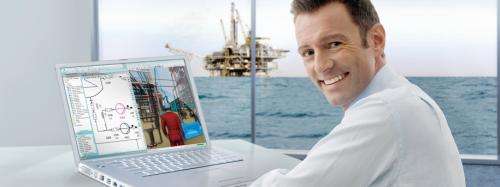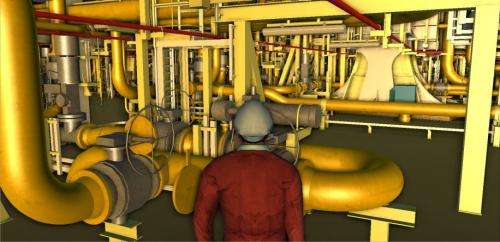Training in the virtual world

3D visualization software makes it possible for users to immerse themselves in a virtual model of a facility. In-depth training sessions prepare technicians for future challenges.
In an oil industry nightmare, a leaky pipe on a production platform has caught fire. The flames spread rapidly, and dense black smoke rises from the lower deck. The crew has to respond within seconds to prevent a disaster. Despite the heat, service technician Björn Meyers keeps his cool. He quickly triggers an alarm and makes his way to an evacuation point while firefighters begin to put out the flames. The fire is quenched in no time and the danger is over.
Meyers takes off his goggles. Although he was on an oil platform just a second ago, he is now in a training room on dry land. The screen in front of him depicts an avatar in whose virtual body Meyers just overcame the dangerous situation described.
Nicolas Tarisse, the man in charge of training oil platform workers at TOTAL E&P, is satisfied with the results. "Only intensive training can ensure that our employees can respond correctly to dangerous situations," he says. However, training workers on remote offshore installations is a laborious and expensive undertaking. That's why TOTAL uses a new instruction system called the Immersive Training Simulator (ITS). Similar to a computer game, the system is based on a software solution from Siemens known as COMOS Walkinside that enables users to immerse themselves in a virtual model of the platform. Course participants can move freely throughout the virtual environment. They can also talk to one another and work together on a variety of scenarios. Studies prove that such immersive training courses are effective. People are much more likely to remember actions they have performed themselves than those taught in classrooms or shown in videos.

However, ITS is not only used to help people deal with dangerous situations and learn about occupational safety measures. It is also effective in teaching typical work steps and the right way to operate a facility. That way, employees can familiarize themselves with their future working environment long before they actually set foot in a real-life facility. An example of this is TOTAL's Pazflor platform, for which the crew was able to begin its training while the facility was still under construction. The training sessions in the virtual model reduced the time needed to prepare workers for their tasks, thus helping to put the oil platform off the coast of Angola into operation more than two months earlier than planned.
Total Overview
In additon to training, 3D visualization can also be used for other purposes. For example, it can enable all the people involved in a project to virtually walk through a realistic 3D model of a facility that is still in an early stage of planning. Among other things, this can ensure that all of the facility's areas and equipment can be easily reached later on.
The system also simplifies the facility's subsequent operation. The more complex a facility is, the more difficult it is to manage the documentation and keep it up to date. COMOS serves as a global data center for such tasks. "3D CAD models of a facility are created during the engineering stage," explains Marc de Buyl, a Siemens expert for 3D visualization. "This data can continue to be used in COMOS so that users also have direct access to the latest facility data when it is in operation." This ensures efficient maintenance and enables the facility to be comprehensively monitored and managed. In virtual models, users can call up additional information about each part of the facility. For example, an employee standing in front of a pump in the virtual world of COMOS Walkinside could directly access associated datasheets. Conversely, he or she could also call up a facility from a database and use COMOS Walkinside to "beam" directly to the corresponding location on the virtual oil platform. In this way, maintenance work can be much more easily planned and simulated in advance. This ensures that all of the required materials are on hand at the maintenance site and that the work can be performed safely and efficiently.
Future Applications
More simulations and applications are continuously being added to COMOS. "In the future, we want to integrate the time aspect into the software in the form of a 4D simulation," explains de Buyl. Doing so will make it possible for a virtual model to also depict the progress being made in a facility's installation. In addition, developers are striving to make the software usable with mobile devices and improving the possibilities for global cooperation between project teams. In addition to the oil and gas industry, the software will increasingly be used for chemical plants and facilities in other process industries.
Björn Meyers puts on his 3D goggles again to ready himself for his next mission. He has two minutes to restart a pump—the countdown is under way.
Provided by Siemens



















